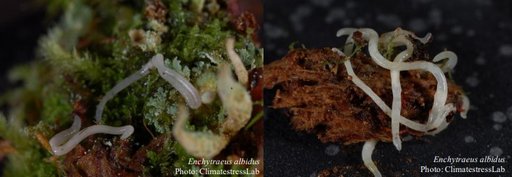Analysis of thermal preference of Enchytraeus albidus, a freeze-tolerant worm distributed from temperate to Arctic regions
Master thesis project

Project description As ectotherms, invertebrates have limited means of regulating their own body temperature and therefore rely on the environmental temperature. The distribution of terrestrial invertebrates is therefore largely determined by environmental temperatures (Angilleta, 2009). Two traits are likely to be relevant for the spatial and temporal distribution of invertebrates include: the thermal tolerance of a species, i.e., capacity to survive high or low temperatures (Deutsch et al., 2008; Sunday et al., 2011) and the thermal preference, i.e., the capacity to track optimal temperatures through behavioral thermoregulation (Huey et al., 2012; Kearney et al., 2009). Due to climate change, there is an urgent need to evaluate these traits to assess the probability of population survival and persistence under climate change scenarios. In a recent study, we have evaluated the thermal tolerance of a small freeze-tolerant worm, E. albidus, collected from 24 geographically distinct populations. Collected along the thermal gradient, these populations differ in their annual mean temperature, with Artic populations experimenting colder annual mean temperatures than the temperate populations. We have demonstrated that while heat tolerance did not differ between the 24 populations, cold tolerance did vary between these populations, with Arctic populations surviving temperatures being 10 °C lower than those of temperate population (Holmstrup et al., 2022). The aim of this project is therefore to determine the second trait that determine invertebrates’ distribution, i.e., the thermal preference in E. albidus and whether this trait differ along the thermal gradient. To test this hypothesis, the candidate will 1) help our research group in developing the technique for measuring thermal preference in our species, and 2) using the geographically distinct populations collected along the thermal gradient (Arctic and temperate populations), evaluate the thermal preference of E. albidus according to populations origin temperature.
For further information contact:
Supervisor: Jesper Givskov Sørensen, Genetics, Ecology and Evolution: jesper.soerensen@bio.au.dk, Co-supervisor: Morgane Naomi Touzot, Ecoscience - Terrestrial Ecology: morgane.touzot@ecos.au.dk
References
Angilleta, M., 2009. Thermal Adaptation. A Theoretical and Empirical Synthesis., Oxford University Press. ed.
Deutsch, C.A., Tewksbury, J.J., Huey, R.B., Sheldon, K.S., Ghalambor, C.K., Haak, D.C., Martin, P.R., 2008. Impacts of climate warming on terrestrial ectotherms across latitude. Proc. Natl. Acad. Sci. 105, 6668–6672. https://doi.org/10.1073/pnas.0709472105
Holmstrup, M., Sørensen, J.G., Dai, W., Krogh, P.H., Schmelz, R.M., Slotsbo, S., 2022. Analysis of heat and cold tolerance of a freeze-tolerant soil invertebrate distributed from temperate to Arctic regions: evidence of selection for extreme cold tolerance. J. Comp. Physiol. B 192, 435–445.
Huey, R.B., Kearney, M.R., Krockenberger, A., Holtum, J.A.M., Jess, M., Williams, S.E., 2012. Predicting organismal vulnerability to climate warming: roles of behaviour, physiology and adaptation. Philos. Trans. R. Soc. B Biol. Sci. 367, 1665–1679. https://doi.org/10.1098/rstb.2012.0005
Kearney, M., Shine, R., Porter, W.P., 2009. The potential for behavioral thermoregulation to buffer “cold-blooded” animals against climate warming. Proc. Natl. Acad. Sci. 106, 3835–3840. https://doi.org/10.1073/pnas.0808913106
Sunday, J.M., Bates, A.E., Dulvy, N.K., 2011. Global analysis of thermal tolerance and latitude in ectotherms. Proc. R. Soc. B Biol. Sci. 278, 1823–1830. https://doi.org/10.1098/rspb.2010.1295
Projektforlaget er lagt op 15.06.2024